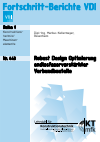Zusammenfassung
Abstract
Components made of continous fiber-reinforced plastics can reach a great lightweight potential if the material is aligned with the direction of the force. The advantages that come along with the high stiffness at low mass justify the use in a wide range of industry although the manufacturing cost might be higher than for
other conventional materials. But with the possibilities to locally influence the mechanical properties there are complicated mechanismen that must be handled and that can be quite challenging for constructions. And also the manufacturing processes which are often done by hand can have significant scatter that might influence the product performance in a negative way.
For this reason the objective of this work is to develop an approach based on the finite element method that supports the product developer in the early embodiment design stage to improve an existing layer stack in terms of low weight while keeping the probability of failure low. For this purpose...
Schlagworte
Robust Verbundbauteile faserverstärkt Robust Design Optimization Faserverbundwerkstoffe Feldstatistik Sensitivitätsstudie Robustheitsbewertung klassische Laminattheorie Pretest Analyse Abgleich Kalibrierung- 1–4 1 Einleitung 1–4
- 135–146 9 Literaturverzeichnis 135–146

